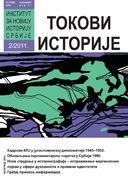Prilog proučavanju industrijske konjunkture u Kraljevini Jugoslaviji - proizvodnja uglja od 1920. do 1938. godine
A Contribution to the Study of Industrial Situation in the Kingdom of Yugoslavia - Coal Production 1920-1938
Author(s): Jelena PetakovićSubject(s): History
Published by: Institut za noviju istoriju Srbije
Keywords: Kingdom of Yugoslavia; industry; mining; coal; economic situation
Summary/Abstract: The article examines the production of coal between 1920 and 1938 on the national level in the Kingdom of Yugoslavia and on the level of its component provinces by using econometric method for examining industrial output. The question of coal as a factor of industrialization was also analyzed by examination of the number of labor force and the use of coal as a fuel. The total coal production in Yugoslavia had a declining tendency and it followed European cycles of production, which was conditioned by the share of brown coal in the exploatation. The production of anthracite marked significant (unreasonable) expansion of as much as 4.000% but it didn’t follow the completelly the world economic cycles, whereas the production of brown coal and lignite corresponded to the economic cycles of European nations. Within the Kingdom of Yugoslavia mines in Serbia were absolutelly dominant in the production of antracite and the mines in Slovenia in production of brown coal and lignite. The production of brown coal in BosniaHerzegovina, Serbia, Croatia, Syrmium, Slavonia and Dalmatia kept rising and it didn’t follow economic cycles, unlike the production of brown coal in Slowenia that completelly corresponed with production cycles. This poses the question if the economy of the Kingdom of Yugoslavia functioned on the national or on provincial level? Consumption and import of coal was on significant rise between 1920 and 1929. After that came a slump and slowing down of rise. The number of employees in coal mines ranged between 29.000 and 31.000 throughout this period, which testifies that coal mining industry couldn’t participate to a larger extent in the industrialisation of the country, despite the rise in production and productivity. Thus the Faculty became the kernel of scholarly and cultural gathering, from where the whole process of education in the SouthEastern
Journal: Tokovi istorije
- Issue Year: 2011
- Issue No: 2
- Page Range: 42-61
- Page Count: 20
- Language: Serbian

